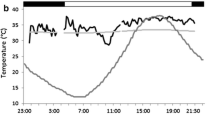Abstract
A variety of definitions involving body temperature (T b), metabolic rate and behavior have been used to define torpor in mammals and birds. This problem is confounded in some studies of free-ranging animals that employ only skin temperature (T sk), a measure that approximates but may not precisely reflect T b. We assess the accuracy of T sk in the context of a recent definition for torpor called active temperature. We compared the active temperatures of individual big brown bats (Eptesicus fuscus), which aggregate in cavities, with solitary, foliage-roosting hoary bats (Lasiurus cinereus). In captive big brown bats, we compared T sk and core T b at a range of ambient temperatures for clustered and solitary roosting animals, compared T sk and T b during arousal from torpor, and quantified the effect of flight on warming from torpor. Hoary bats had significantly lower active temperatures than big brown bats despite having the same normothermic T sk. T sk was significantly lower than T b during normothermia but often greater than T b during torpor. Flight increased the rate of warming from torpor. This effect was more pronounced for T sk than T b. This suggests that bats could rely on heat generated by flight muscles to complete the final stages of arousal. Using active temperature to define torpor may underestimate torpor due to ambient cooling of external transmitters or animals leaving roosts while still torpid. Conversely, active temperature may also overestimate shallow torpor use if it is recorded during active arousal when shivering and non-shivering thermogenesis warm external transmitters. Our findings illuminate the need for laboratory studies that quantify the relationship between metabolic rate and T sk over a range of ambient temperatures.







Similar content being viewed by others
Abbreviations
- BAT :
-
brown adipose tissue
- MR :
-
metabolic rate
- T a :
-
ambient temperature
- T act :
-
active temperature
- T b :
-
body temperature
- T sk :
-
skin temperature
References
Aldridge HDJN, Brigham RM (1988) Load carrying and maneuverability in an insectivorous bat: a test of the 5% "rule" of radio telemetry. J Mammal 69:379–383
Audet D, Thomas DWT (1996) Evaluation of the accuracy of body temperature measurement using external radio transmitters. Can J Zool 74:1778–1781
Augee ML (1969) Temperature regulation and adrenal function in the echidna. Ph.D. Thesis. Department of Zoology, Monash University, Clayton Victoria, Australia
Austen GT, Bradley WG (1969) Additional responses of the poor-will to low temperatures. Auk 86:717–725
Barclay RMR, Kalcounis MC, Crampton LH, Stefan C, Vonhof MJ, Wilkinson L, Brigham RM (1996) Can external radiotransmitters be used to assess body temperature and torpor in bats. J Mammal 77:1102–1106
Barclay RMR, Lausen CL, Hollis L (2001) What's hot and what's not: defining torpor in free-ranging birds and mammals. Can J Zool 79:1885–1890
Barnes BM (1989) Freeze avoidance in a mammal: body temperatures below 0°C in an arctic hibernator. Science 241:1521–1616
Bartholomew GA, Dawson WR, Lasiewski RC (1970) Thermoregulation and heterothermy in some of the smaller flying foxes (Megachiroptera) of New Guinea. Z Vgl Physiol 70:196–209
Bradley WG, O'Farrell MJ (1969) Temperature relationships in the Western Pipistrelle, (Pipistrellus hesperus). In: Hoff CC, Riedesel ML (eds). Physiological systems in semiarid environments. University of New Mexico Press, Albequerque, New Mexico, pp 85–96
Brigham RM (1992) Daily torpor in a free-ranging goatsucker, the common poorwill (Phaelaenoptilus nuttallii). Physiol Zool 65:457–472
Brigham RM, Körtner G, Geiser F (2000) Seasonal use of torpor by free-ranging Australian owlet nightjars. Physiol Biochem Zool 73:613–620
Choi I, Cho Y, Oh YK, Jung N-P, Shin H-C (1998) Behaviour and muscle performance in heterothermic bats. Physiol Zool 71:257–266
Chruszcz BJ, Barclay RMR (2002) Thermoregulatory ecology of a solitary bat, Myotis evotis, roosting in rock crevices. Funct Ecol 16:18–26
The Commission for Thermal Physiology of the International Union of Physiological Sciences (2001) Glossary of terms for thermal physiology. Jap J Physiol 51:245–280
Eckert R, Randall D, Augustine G (1988) Animal physiology: mechanisms and adaptations. WH Freeman, New York
Fons R, Sender S, Peters T, Jürgens D (1997) Rates of rewarming, heart and respiratory rates and their significance for oxygen transport during arousal from torpor in the smallest mammal, the etruscan shrew, Suncus etruscus. J Exp Biol 200:1451–1458
Geiser F, Baudinette RV (1990) The relationship between body mass and rate of rewarming from hibernation and daily torpor in mammals. J Exp Biol 151:349–359
Geiser F, Brigham RM (2000) Torpor, thermal biology, and energetics in Australian long-eared bats (Nyctophilus). J Comp Physiol B 170:153–162
Geiser F, Ferguson C (2001) Intraspecific differences in behaviour and physiology: effects of captive breeding on patterns of torpor in feathertail gliders. J Comp Physiol B 171:569–576
Geiser F, Ruf T (1995) Hibernation vs. daily torpor in mammals and birds: physiological variables and classification of torpor patterns. Physiol Zool 68:935–966
Geiser F, Coburn DK, Körtner G (1996) Thermoregulation, energy metabolism, and torpor in blossom-bats, Syconycteris australis (Megachiroptera). J Zool (Lond) 239:583–590
Geiser F, Holloway JC, Körtner G, Maddocks TA, Turbill C, Brigham RM (2000) Do patterns of torpor differ between free-ranging and captive mammals and birds? In: Heldmaier G, Klingenspor M (eds) Life in the Cold. Proceedings of the 11th International Hibernation Symposium, 13–18 August 2000, Jungolz Austria. Springer, Berlin Heidelberg New York, pp 95–102
Genoud M (1993) Temperature regulation in subtropical tree bats. Comp Biochem Physiol A 104:321–331
Hamilton IM, Barclay RMR (1994) Patterns of daily torpor and day roost selection by male and female big brown bats (Eptesicus fuscus). Can J Zool 72:744–749
Hickey MBC, Fenton MB (1996) Behavioural and thermoregulatory responses of female hoary bats, Lasiurus cinereus (Chiroptera: Vespertilionidae), to variations in prey availability. Ecoscience 3:414–422
Kalcounis MC, Brigham RM (1998) Secondary use of aspen cavities by tree-roosting big brown bats. J Wildlife Manage 62:603–611
Kunz TH (1982) Roosting ecology. In: Kunz TH (ed) Ecology of bats. Plenum, New York, pp 151–200
Lausen CL (2001) Thermoregulation and roost selection by reproductive female big brown bats (Eptesicus fuscus) roosting in rock crevices in the South Saskatchewan River Valley, Alberta. Abstracts of the 31st Annual North American Symposium on Bat research, Victoria, BC Canada, 24–27 October 2001
Lausen CL, Barclay RMR (2003) Thermoregulation and roost selection by reproductive female big brown bats (Epesicus fuscus) roosting in rock crevices. J Zool (Lond) (in press)
Ortmann S, Shmid J, Ganzhorn JU, Heldmaier G (1996) Body temperature and torpor in a Malagasy small primate, the mouse Lemur. In: Geiser F, Hurlbert AJ, Nicol SC (eds) Adaptations to the Cold. Tenth International Hibernation Symposium. University of New England Press, Armidale Australia, pp 55–61
Saarela S, Keith JS, Hohtola AE, Trayhurn P (1991) Is the mammalian brown fat specific mitochondrial uncoupling protein present in adipose tissue of birds? Comp Biochem Physiol B 100:45–50
Sauchyn DJ (1993) Quaternary and late tertiary landscape evolution in the western Cypress Hills. In: Sauchyn DJ (ed) Quaternary and late tertiary landscapes of Southwestern Saskatchewan and adjacent areas. Canadian Plains Research Centre, Regina Canada
Schmid J (1996) Oxygen consumption and torpor in mouse lemurs (Microcebus murinus and M. myoxinus): preliminary results of a study in western Madagascar. In: Geiser F, Hurlbert AJ, Nicol SC (eds) Adaptations to the Cold. Tenth International Hibernation Symposium. University of New England Press, Armidale Australia, pp 47–54
Stone GN, Purvis A (1992) Warm-up rates during arousal from torpor in heterothermic mammals: physiological correlates and a comparison with heterothermic insects. J Comp Physiol B 162:284–295
Studier EH (1981) Energetic advances of slight drops in body temperature in little brown bats, Myotis lucifugus. Comp Biochem Physiol A 70:537–540
Wang LCH (1989) Ecological, physiological and biochemical aspects of torpor in mammals and birds. In: Wang LCH (ed) Advances in comparative and environmental physiology. Springer, Berlin Heidelberg New York, pp 361–401
Wang LCH, Wolowyk MW (1988) Torpor in mammals and birds. Can J Zool 66:133–137
Willis CKR (2003) Daily heterothermy by temperate bats using natural roosts. In: Akbar Z, McCracken GF, Kunz TH (eds) Functional and evolutionary ecology of bats. Proceedings of the 12th International Bat Research Conference. Oxford University Press, New York (In press)
Willis CKR, Kolar KA, Karst AL, Kalcounis-Rueppell MC, Brigham RM (2003) Medium- and long-term reuse of trembling aspen cavities as roosts by big brown bats (Eptesicus fuscus). Acta Chiropterol (In press)
Zar JH (1999) Biostatistical analysis. Prentice Hall, New Jersey
Acknowledgements
Despite our disagreement with him on some of the issues raised above, we wish to express our admiration for the important contributions of Robert Barclay and his students to the study of torpor in free-ranging animals. We also thank Dr. Barclay for comments that improved an early draft of the manuscript. Andrew McKechnie, Don Thomas, and Chris Woods also provided helpful comments. Field and laboratory assistance was provided by Quinn Fletcher, Amanda Karst, Brianna Dobson, Renee Bendig, Desiree Idt, Christine Voss, Seb Martinez, Ryan Fisher, and Julie Adams. Jim Rusak provided invaluable statistical suggestions. This research was funded by Mountain Equipment Co-op, Saskatchewan Environment and Resource Management and by a Natural Sciences and Engineering Research Council (NSERC, Canada) research grant to R.M.B. and postgraduate scholarship to C.K.R.W.
Author information
Authors and Affiliations
Corresponding author
Additional information
Communicated by L.C.H. Wang
Rights and permissions
About this article
Cite this article
Willis, C.K.R., Brigham, R.M. Defining torpor in free-ranging bats: experimental evaluation of external temperature-sensitive radiotransmitters and the concept of active temperature. J Comp Physiol B 173, 379–389 (2003). https://doi.org/10.1007/s00360-003-0343-y
Accepted:
Published:
Issue Date:
DOI: https://doi.org/10.1007/s00360-003-0343-y




